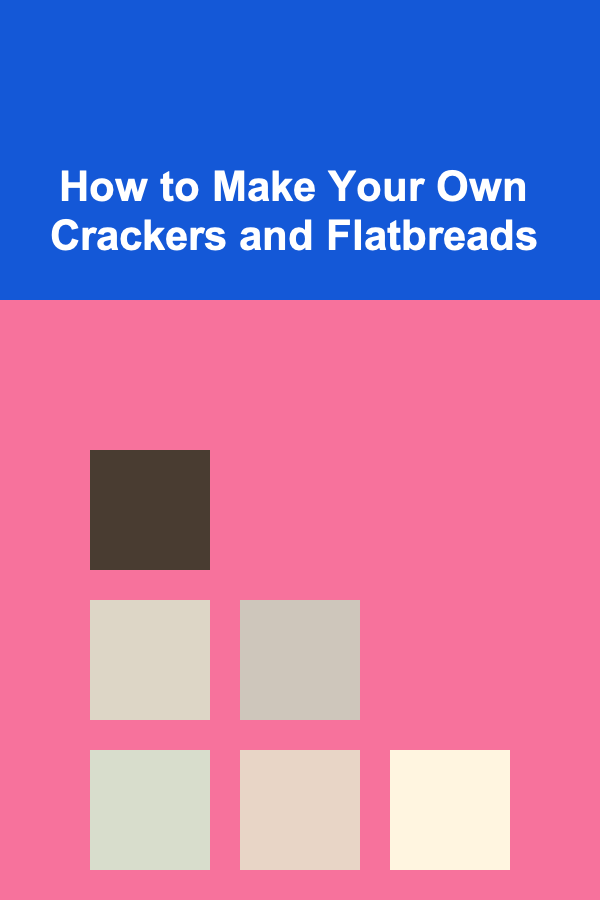
How to Make Your Own Crackers and Flatbreads
ebook include PDF & Audio bundle (Micro Guide)
$12.99$6.99
Limited Time Offer! Order within the next:

Baking your own crackers and flatbreads is an enriching and rewarding experience. These simple yet versatile snacks can be customized to suit a wide range of tastes, from the classic buttery cracker to the more complex, spicy flatbreads. Making them at home allows you to control the ingredients, avoid preservatives, and create something fresh, flavorful, and healthy. This comprehensive guide will walk you through the essentials of crafting your own crackers and flatbreads from scratch, covering the ingredients, techniques, and different variations you can try.
The Basics of Crackers and Flatbreads
Before we dive into the details of making your own crackers and flatbreads, let's first understand what they are and why they are so beloved in cuisines around the world.
Crackers
Crackers are dry, crisp, baked snacks made from a mixture of flour, water, and sometimes fat or other flavorings. They are usually thin and crisp, designed to be easily broken into smaller pieces. Crackers are incredibly versatile---they can be served as an accompaniment to cheeses, dips, or soups, or simply eaten on their own. The key to making a good cracker is balancing the dough's moisture content and ensuring the right baking temperature to get that delightful crunch.
Flatbreads
Flatbreads are an ancient form of bread found in many cultures around the world, including Mediterranean, Middle Eastern, and Indian cuisines. They are usually unleavened, meaning they don't require yeast or a rising agent. Instead, the dough is simply rolled out thin and baked or cooked on a griddle. Flatbreads can vary in thickness, texture, and flavor depending on the region, but they are all characterized by their simple ingredients and quick preparation.
The Ingredients You'll Need
For both crackers and flatbreads, the basic ingredients are fairly similar, with some variations depending on the desired outcome.
1. Flour
Flour is the main structure of both crackers and flatbreads. Different types of flour can be used, each contributing different textures and flavors.
- All-purpose flour is commonly used for both crackers and flatbreads. It provides a soft texture but still holds up well to crisping or baking.
- Whole wheat flour gives a nuttier, heartier flavor and denser texture.
- Gluten-free flours (such as rice flour or chickpea flour) can also be used for those with dietary restrictions.
2. Fats
Adding fat to your dough can help achieve a flaky, crisp texture in crackers and a tender, moist flatbread. Fats commonly used include:
- Butter or olive oil for flavor and richness.
- Coconut oil for a subtle tropical flavor.
- Ghee (clarified butter) for a slightly nutty, richer flavor that works particularly well in Indian-style flatbreads.
3. Water
Water helps bind the flour and fat together, creating a dough that is easy to roll and shape. The amount of water you need will depend on the flour you use, but it's usually just enough to bring the dough together without being too sticky.
4. Salt
Salt is a crucial ingredient for enhancing the flavor of both crackers and flatbreads. It also helps balance out the richness of the fat and any sweetness in the dough.
5. Leavening Agents (Optional for Flatbreads)
Most crackers are unleavened, but some flatbreads may require a leavening agent like baking powder or yeast to give them a bit of rise. Yeast is traditionally used for flatbreads like naan or pita , but many simpler flatbreads, such as chapati or tortillas, do not need any leavening agents.
6. Flavorings and Add-ins
For both crackers and flatbreads, flavorings like herbs , spices , cheese , seeds , and even garlic can be incorporated into the dough for extra depth. These ingredients add a unique twist to each batch, whether you're making savory crackers or experimenting with sweet flatbreads.
How to Make Crackers from Scratch
Making homemade crackers is straightforward but requires careful attention to achieve the right texture. Here's a step-by-step guide:
1. Prepare Your Dough
In a mixing bowl, combine:
- 1 cup of flour (all-purpose or whole wheat)
- 1/4 cup of butter (cold and cubed) or olive oil
- 1/2 teaspoon of salt
- 1/4 cup of water (more if needed)
Use your fingers or a pastry cutter to work the fat into the flour until the mixture resembles coarse crumbs. Add water slowly, one tablespoon at a time, and mix until the dough begins to come together.
2. Roll Out the Dough
Once the dough is formed, turn it out onto a lightly floured surface and roll it out as thinly as possible, aiming for about 1/8 inch thick. The thinner the dough, the crisper the crackers will be.
3. Cut into Shapes
Using a sharp knife or cookie cutter, cut the dough into your desired shapes. Traditional crackers are often rectangular or square, but you can experiment with different shapes, such as circles or diamonds.
4. Bake the Crackers
Preheat your oven to 350°F (175°C). Place the cut dough pieces on a baking sheet lined with parchment paper. For a glossy finish, you can brush the crackers with a little olive oil and sprinkle with additional salt or herbs.
Bake the crackers for 10-15 minutes, or until they are golden brown and crisp. Keep a close eye on them to prevent burning. Once they're done, remove them from the oven and allow them to cool completely before storing.
5. Customize Your Crackers
You can easily customize the flavor of your crackers by adding ingredients such as:
- Herbs: Rosemary, thyme, or oregano can add an aromatic, savory touch.
- Seeds: Sunflower seeds, sesame seeds, or flaxseeds add crunch and nutrition.
- Cheese: Grated parmesan or cheddar gives a cheesy, savory flavor to the crackers.
How to Make Flatbreads from Scratch
Now that we've covered crackers, let's move on to flatbreads. Whether you're making simple tortillas , naan , or pita, the process is similar, though each type of flatbread has unique characteristics.
1. Mix the Dough
Start by combining:
- 2 cups of flour (you can use all-purpose, whole wheat, or a blend)
- 1/2 teaspoon of salt
- 1 tablespoon of olive oil (or melted butter)
- 3/4 cup of warm water (or more, as needed)
- 1 teaspoon of sugar (optional, to feed the yeast if making yeasted flatbreads)
For yeasted flatbreads, add 1 teaspoon of active dry yeast to the flour mixture and allow it to sit for about 5 minutes to activate. Mix the ingredients until a dough forms.
2. Knead the Dough
Turn the dough out onto a floured surface and knead for about 5-10 minutes until it becomes smooth and elastic. If the dough is too sticky, add more flour, a little at a time. If it's too dry, add a few drops of water.
3. Rest the Dough
Cover the dough with a clean cloth or plastic wrap and let it rest for at least 30 minutes. This resting period allows the gluten to relax, making the dough easier to roll out.
4. Roll Out the Flatbread
Once rested, divide the dough into small balls (about the size of a golf ball). Roll each ball out into a thin circle or oval on a floured surface. The thickness of the flatbread will vary depending on your preference, but generally, thinner flatbreads cook faster and become more crispy.
5. Cook the Flatbreads
For Pan-Fried Flatbreads:
Heat a heavy-bottomed skillet or griddle over medium-high heat. Once hot, place the rolled-out dough onto the pan and cook for 1-2 minutes per side, or until it puffs up and has golden brown spots.
For Oven-Baked Flatbreads (like pita):
Preheat your oven to 475°F (245°C). Place the flatbreads on a baking sheet and bake for 5-7 minutes, or until they puff up and turn golden.
6. Serve and Enjoy
Flatbreads are best enjoyed fresh out of the pan or oven. Serve them warm with dips like hummus, yogurt, or tzatziki, or use them as a base for wraps, pizzas, or sandwiches.
Variations to Try
While the basic recipes for crackers and flatbreads are simple, there's plenty of room for creativity. Here are a few variations you can try:
Savory Crackers
- Cheddar and Chive Crackers: Add sharp cheddar cheese and chopped fresh chives to the dough for a rich, herby flavor.
- Garlic and Herb Crackers: Infuse your dough with roasted garlic and your favorite herbs like rosemary, thyme, and oregano.
- Spicy Crackers: Add a pinch of cayenne pepper, chili flakes, or paprika for a zesty kick.
Sweet Crackers
- Cinnamon-Sugar Crackers: Brush the crackers with butter and sprinkle with cinnamon and sugar for a sweet treat.
- Almond and Honey Crackers: Add ground almonds and a drizzle of honey to the dough for a subtly sweet flavor.
Flatbread Variations
- Naan: For a richer flatbread, add yogurt and ghee to the dough, and cook on a hot griddle. Serve with curries.
- Pita: For puffy pita, add a little yeast to the dough and bake at a high temperature for that signature pocket.
- Chapati: A traditional Indian flatbread made with whole wheat flour, chapatis are soft and ideal for scooping up stews and curries.
Conclusion
Making your own crackers and flatbreads is a simple, enjoyable process that results in delicious, fresh snacks and breads. With just a few basic ingredients and a little patience, you can create a wide variety of these beloved foods. Whether you prefer your crackers thin and crispy or your flatbreads soft and puffy, the possibilities for customization are endless. So roll up your sleeves, get your ingredients ready, and start baking---your homemade crackers and flatbreads are just a few steps away from being enjoyed!

How to Maximize Closet Space with Creative Storage Solutions
Read More
How to Organize Post-Wedding Tasks Like Thank You Cards
Read More
How to Organize Recipes with Visual Inspiration Boards
Read More
How to Use Shelving Units to Optimize Your Space
Read More
How to Understand Push-Your-Luck Board Games
Read More
How to Backtest Forex Strategies Like a Pro
Read MoreOther Products

How to Maximize Closet Space with Creative Storage Solutions
Read More
How to Organize Post-Wedding Tasks Like Thank You Cards
Read More
How to Organize Recipes with Visual Inspiration Boards
Read More
How to Use Shelving Units to Optimize Your Space
Read More
How to Understand Push-Your-Luck Board Games
Read More